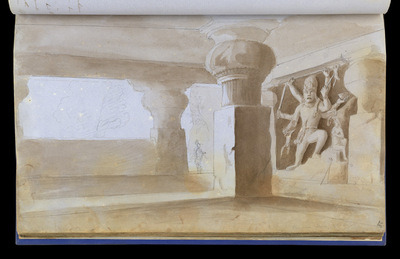Javascript must be enabled to continue!
f.28 Entrance to Dumar Lena Cave with sculpture of Siva's Dance in the Elephant Skin, Cave 29, Ellora. 'Dhurma Lena. 26 Sept.'
View through Europeana Collections
Wash and watercolour drawing of the Dhumar Lena,
Cave 29 at Ellora, from an Album of 83 drawings; 80 of landscapes
and antiquities in the northem Deccan, 2 portraits and 1 flower
study made during a tour chiefly to Ellora, Rauza, Daulatabad,
Aurangabad and Ajanta. September to November 1849. Although the
artist is unidentified, these drawings are of some interest since
they show the state of the Ajanta and Ellora Caves soon after the
Royal Asiatic Society had brought them to the Company's notice in
1844. Robert Gill had been deputed to make a record of Ajanta in
1846 and was presumably on the spot when these sketches were
made.The spectacular site of Ellora, in Maharashtra, is famous for
its series of Buddhist, Hindu and Jain cave temples excavated into
the rocky façade of a cliff of basalt along more than 2 km. The
works were done under the patronage of the Kalachuri, the Chalukya
and the Rashtrakuta dynasties between the sixth and the ninth
centuries. Dhumar Lena is one of the earliest caves of the Hindu
series and dates from the Kalachuri period, early 6th century, as
denoted by the similarity between its columns and those at the
Elephanta cave. Large-scale sculpted wall panels on the sides
represent Shaivite myths. The sculpture depicted in this drawing
depicts a ferocius aspect of Shiva; he is represented with eight
arms, two of them holding the spear impaling the demon Andhaka,
shown at the top left corner. The other two figures in the
composition are Devi seated with a female
attendant.
Title: f.28 Entrance to Dumar Lena Cave with sculpture of Siva's
Dance in the Elephant Skin, Cave 29, Ellora. 'Dhurma Lena. 26
Sept.'
Description:
Wash and watercolour drawing of the Dhumar Lena,
Cave 29 at Ellora, from an Album of 83 drawings; 80 of landscapes
and antiquities in the northem Deccan, 2 portraits and 1 flower
study made during a tour chiefly to Ellora, Rauza, Daulatabad,
Aurangabad and Ajanta.
September to November 1849.
Although the
artist is unidentified, these drawings are of some interest since
they show the state of the Ajanta and Ellora Caves soon after the
Royal Asiatic Society had brought them to the Company's notice in
1844.
Robert Gill had been deputed to make a record of Ajanta in
1846 and was presumably on the spot when these sketches were
made.
The spectacular site of Ellora, in Maharashtra, is famous for
its series of Buddhist, Hindu and Jain cave temples excavated into
the rocky façade of a cliff of basalt along more than 2 km.
The
works were done under the patronage of the Kalachuri, the Chalukya
and the Rashtrakuta dynasties between the sixth and the ninth
centuries.
Dhumar Lena is one of the earliest caves of the Hindu
series and dates from the Kalachuri period, early 6th century, as
denoted by the similarity between its columns and those at the
Elephanta cave.
Large-scale sculpted wall panels on the sides
represent Shaivite myths.
The sculpture depicted in this drawing
depicts a ferocius aspect of Shiva; he is represented with eight
arms, two of them holding the spear impaling the demon Andhaka,
shown at the top left corner.
The other two figures in the
composition are Devi seated with a female
attendant.
Related Results
f.25 Dumar Lena Cave with sculpture of Ravana rocking Mount
Kailasa, Cave 29, Ellora. 'Entrance to Dhurma Lena. Septr.
25.'
f.25 Dumar Lena Cave with sculpture of Ravana rocking Mount
Kailasa, Cave 29, Ellora. 'Entrance to Dhurma Lena. Septr.
25.'
Wash and watercolour drawing of the sculpture of
Ravana shaking Mount Kailasa from Dhumar Lena, Cave 29 at Ellora,
from an Album of 83 drawings; 80 of landscapes and antiquities in...
Inscribed on reverse: 'Tin Tal Cave Ellora. March
1847'
Inscribed on reverse: 'Tin Tal Cave Ellora. March
1847'
Water-colour by Charles Power Cobbe of the Tin
Tal Cave at Ellora, dated March 1847. Inscribed on reverse: 'Tin
Tal Cave Ellora. March 1847 CPC'.Charles Power Cobbe was in the 8th
...
Entrance to the cave temple of Karle. Copy of an original
sketch of 1805
Entrance to the cave temple of Karle. Copy of an original
sketch of 1805
Water-colour by James Broff Byers of the entrance
to the cave temple of Karle, dated 1815. Inscribed on reverse:
'View of the Entrance, or External Appearance of the magnificent
Ca...
Nobleman and Trainer Mounted on an Elephant
Nobleman and Trainer Mounted on an Elephant
Seated at the base of the neck of an elephant is a Rajput nobleman, identified by the type of earring he wears and turban style. He carries an elephant goad (ankus) in his left han...
Interior of the Great Shiva Cave, Elephanta, looking north
towards the entrance
Interior of the Great Shiva Cave, Elephanta, looking north
towards the entrance
Water-colour with ruled and wash borders drawing
of the interior of the great Siva cave temple at Elephanta, looking
north towards the entrance, by James Wales, dated c.1794. The g...
Archaeological Watching Monitoring, the Eastern part of the Sacristian vaults with cracks and secondary layers in the painting, Lena church, Lena parish 2018
Archaeological Watching Monitoring, the Eastern part of the Sacristian vaults with cracks and secondary layers in the painting, Lena church, Lena parish 2018
Archaeological Watching Monitoring, the Eastern part of the Sacristian vaults with cracks and secondary layers in the painting, Lena church, Lena parish 2018...
Breechcloth
Breechcloth
Breechcloth; probably Yanktonai; 1860-1870Wool, porcupine quills, sinew, metal, horsehair, pigments; 117.5 x 28.5 cm.\RMV 710-9; Herman F.C. ten Kate collection; purchased from tra...
Preparatory Drawing of a Chained Elephant Drinking Water
Preparatory Drawing of a Chained Elephant Drinking Water
The large elephant is composed of red and black lines that demonstrate the various stages of the drawing process, from initial sketches to more detailed inclusions. The elephant we...




